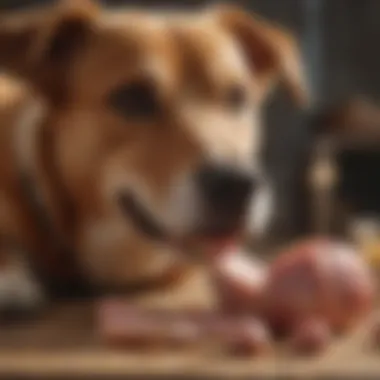Assessing the Risks and Benefits of Ham Bones for Dogs


Intro
The question of whether to feed ham bones to dogs is often debated among pet owners. Understanding the implications involves looking closely at the potential benefits and risks. Ham bones may seem appealing as a treat, but there are significant concerns regarding their safety and nutritional value. It is crucial to analyze veterinary recommendations, different dietary impacts, and any associated health risks.
In this article, we aim to explore these factors extensively, providing pet owners with critical insights to promote the well-being of their dogs. By examining both sides of the argument, we will ultimately furnish guidelines on more suitable treat options for dogs, prioritizing safety and overall health.
Animal Overview
Common Names
In the context of this discussion, the focus is on domestic dogs. Commonly referred to as
Understanding Canine Nutrition
Understanding canine nutrition is crucial for dog owners seeking to make informed decisions about their pets' diets. Knowledge of what constitutes a balanced diet can significantly affect a dog's health and overall well-being. Proper nutrition influences not just physical health, but also behavior, energy levels, and longevity.
Nutritional needs vary by breed, age, and activity level. Dogs require a combination of proteins, carbohydrates, fats, vitamins, and minerals. A well-rounded diet keeps dogs energized and can prevent various health issues related to malnutrition or obesity.
In this context, the role of treats, such as ham bones, should be considered carefully. Treats can enhance a dog's diet if used wisely. However, it is important to know their nutritional value and the frequency of use. Evaluating the balance between regular food and treats is vital for maintaining an optimal diet.
The Role of Treats in a Dog's Diet
Treats serve multiple purposes in a dog's diet. They are not just rewards for good behavior. They also provide mental stimulation and social engagement when dogs are trained using treats. However, treats should not exceed more than 10% of a dog's daily caloric intake.
When considering treats like ham bones, it is important for pet owners to understand both the benefits and risks.
- Nutrient Source: Some treats contain added nutrients that can supplement a dog's diet.
- Motivation: Dogs are often more motivated to learn commands and tricks when treats are involved.
- Bonding Times: Treats can make training and playtime more enjoyable, enhancing the bond between the dog and the owner.
However, not all treats are suitable. It's crucial to assess safety and nutritional value. For example, some bones may splinter or cause digestive issues. Educating oneself on the right types of treats ensures that a dog's diet remains healthy.
Pet owners should prioritize the overall health benefits rather than simply the enjoyment that treats may provide.
Ham Bones: An Overview
Understanding the implications of feeding ham bones to dogs is crucial for pet owners. Ham bones, often deemed a tempting treat, come with a mixture of perceived benefits and significant risks. This overview delves into the nature of ham bones, providing insights that can help dog owners make informed decisions.
Ham bones typically originate from the hind leg of a pig, which is known for its rich flavor. The fat and residual meat often attached to the bone can attract dogs, making it an appealing chewable item. However, key considerations arise regarding the suitability of these bones for canine consumption. Not all dogs will benefit from them. Factors such as breed, size, and existing health issues come into play. Pet owners need to weigh the enjoyment a dog might derive from chewing a ham bone against the potential health implications.
A proper understanding of what ham bones offer will assist in assessing their suitability. It is vital to recognize both the nutritional value they can potentially provide, such as protein and minerals, and the associated health risks that can arise from improper handling or feeding practices. This creates a dual responsibility for pet owners: to appreciate what ham bones can add to a dog’s diet, while also rigorously considering any dangers they may pose.
What Are Ham Bones?
Ham bones are essentially the skeletal remains from pork hams. Once these cuts are prepared for human consumption, the leftover bones can sometimes be fed to dogs. These bones often come from cooked or cured hams that have been processed for various culinary uses. This highlights a relevant consideration; if the bones are cooked, they may pose greater hazards than raw bones due to their propensity to splinter.
Dogs might find ham bones pleasurable to chew due to their size and shape. The dense structure might provide enrichment, serving as a natural dental aide, if in moderation. However, the source of the bone – whether raw or cooked, free of additives or preservatives – determines their safety and nutritional value. Owners must understand these nuances to better assess if providing ham bones is a suitable choice for their pets.
A careful approach is required when considering ham bones for dogs. One must be cautious of the type of ham bones provided and the individual dog's health profile.


In summary, ham bones are more than a simple treat. They involve a complex balance of enjoyment, nutrition, and health considerations, making awareness essential for responsible pet ownership.
Health Benefits of Ham Bones
When considering the suitability of ham bones for dogs, it is essential to examine the health benefits associated with them. These benefits offer insight into the potential advantages of including ham bones in a dog's diet. However, one should also weigh these against the risks mentioned in other sections of this article.
Potential Nutritional Value
Ham bones can provide some nutritional value if offered wisely. They contain protein, which is crucial for muscle development and maintenance in dogs. Also, they can include minerals such as phosphorus and calcium, both of which contribute to strong bones and teeth. However, not all ham bones are created equal. The nutritional content varies based on factors such as the type of ham, preparation method, and overall serving size.
Additionally, ham bones may contain fat. While some fat can be beneficial, as it provides energy, excessive fat can lead to health issues. As with any treat, moderation is vital. Too much fat may result in obesity or pancreatitis in dogs, particularly in breeds that are more susceptible to weight gain.
While ham bones do offer some nutritional advantages, it is wise to consider these factors before giving them to your dog. Always consult with a veterinarian to determine if ham bones fit into your pet's specific dietary needs.
Dental Benefits
Aside from nutritional aspects, ham bones could provide dental benefits to dogs. Chewing on bones can help clean teeth and gums. As dogs gnaw on the bone, it may remove plaque buildup, alleviating the risk of dental problems such as gingivitis or periodontal disease. Regular chewing can stimulate gums, promoting overall oral health.
However, not all bones will provide these benefits. Ham bones that are too soft may crumble and do little for dental hygiene. On the other hand, overly hard bones could present a risk of breaking a dog's teeth. Selecting an appropriate ham bone is essential; it must provide a safe chewing experience while contributing positively to dental health.
Health Risks Associated with Ham Bones
Understanding the health risks associated with ham bones is crucial for any pet owner. While they may seem like a tasty treat for dogs, several factors warrant careful consideration. These risks can lead to serious health complications that might affect your dog's well-being. Therefore, it is critical to recognize that not all treats are suitable and that some can pose significant dangers.
Choking Hazards
Choking is one of the primary concerns when giving dogs ham bones. Dogs may chew aggressively on a bone, leading to the possibility of large chunks breaking off. If a dog swallows a piece that is too big, it could cause choking. The anatomical structure of a dog's throat makes it difficult for them to manage larger objects. Dogs can experience distress and can be at risk of asphyxiation. If a dog shows signs of choking, like pawing at its mouth or struggling to breathe, immediate veterinary attention is needed.
Digestive Issues
Another risk involves digestive problems. Ham bones can be rich in fat and sodium, which might not sit well with all dogs. If they consume too much fat at once, some dogs can develop pancreatitis, a painful inflammation of the pancreas. Other potential issues can include vomiting, diarrhea, and general stomach discomfort. To help mitigate these risks, pet owners should keep an eye on their dog’s overall diet and quirks when consuming certain treats.
Proper monitoring of your dog's reaction to any new treat is vital. Doing so can help detect any adverse reactions early.
Bone Splinters and Injury
Bone splinters present yet another formidable risk. When dogs gnaw on ham bones, the bones can splinter, resulting in sharp fragments. These fragments can injure the dog’s mouth, throat, or even digestive tract. In severe cases, splinters can lead to life-threatening conditions if they pierce internal organs. If you suspect your dog has swallowed splintered bone, it’s advisable to seek veterinary care promptly.
Veterinary Perspectives on Ham Bones
Veterinary perspectives shed light on the often contentious issue of feeding ham bones to dogs. These insights are essential for pet owners to make informed decisions regarding their companion's nutrition and safety. Expert opinions emphasize both the nutritional aspects of ham bones and the potential risks associated with them. After all, veterinarians possess a deep understanding of animal biology and the nutritional requirements of dogs, making their assessments invaluable.
It is crucial to consider that not all bones are created equal. Ham bones come with their own set of benefits and drawbacks. Some veterinarians argue that the nutritional content, particularly when it comes to marrow and certain vitamins, can be beneficial. Others strongly caution against the hazards—such as bone splinters potentially injuring a dog’s mouth or digestive tract.
Expert Opinions
When discussing the feeding of ham bones, a consensus can be elusive among veterinarians. Some veterinarians may highlight the possible nutritional advantages: ham bones can be rich in fat and protein, supporting a dog’s energy needs. While this point is compelling, it often requires balancing the nutritional benefits against the associated risks.
Veterinary experts often emphasize the importance of monitoring a dog's interactions with ham bones.
Some expert opinions suggest that if pet owners choose to provide ham bones, they should do so sparingly and always under supervision. It is advisable to avoid cooked bones as they are more prone to splintering.


"While ham bones can offer certain nutritional benefits, the risks should not be underestimated. Always prioritize your dog's safety."
Understanding this dual perspective allows owners to appreciate the complexity of canine nutrition more completely.
Recommended Alternatives
As the risks associated with ham bones have prompted considerable hesitation, veterinarians frequently suggest several safe alternatives that can satisfy a dog’s chewing instinct without the dangers linked with ham bones. Some recommended options include:
- Raw and safe bones: These are less likely to splinter compared to cooked versions.
- Commercial dog chews: Brands like Nylabone or Benebone provide a safer option than natural bones.
- Vegetable-based treats: Many dogs enjoy crunchy snacks made from natural ingredients like sweet potatoes or carrots.
- Edible dental chews: These can promote oral health while satisfying the chew desire.
Each of these alternatives allows for safe chewing while still providing some nutritional value and mental stimulation. Emphasizing dental health and proper nutrition protects dogs from potential injuries associated with ham bones, thereby promoting responsible pet ownership.
How to Safely Introduce Treats
Introducing new treats to a dog's diet must be done with care. This section looks into why it is essential to approach the introduction of ham bones or any new treat thoughtfully. Understanding the behavior and dietary responses of a dog when presented with a different food item can minimize risks of adverse reactions. Moreover, it promotes a structured way to enhance the overall diet of dogs.
Monitoring Reactions
When introducing ham bones, it's crucial to monitor your dog's behavior and physical reactions. Dogs may exhibit different responses ranging from excitement to discomfort. Here are some points to consider:
- Watch for Allergic Reactions: Signs may include itching, swelling, or gastrointestinal distress. If your dog shows any of these, discontinue the treat immediately.
- Observe Digestive Changes: Soft stools or vomiting could indicate intolerance. Note any changes in your dog's regular bowel movements.
- Behavioral Changes: Increased aggression or refusal to eat other foods may signal discomfort or dissatisfaction with the treat.
Engaging regularly and assessing any physical or behavioral changes can aid in deciding if ham bones are suitable.
Establishing Portion Control
Portion control is vital when introducing ham bones as treats. Excess treats can lead to unhealthy weight gain or dietary imbalances. Here are suggested practices:
- Appropriate Size: Ensure the size of the ham bone is suitable for your dog's size and breed. Larger dogs may manage bigger bones, while small breeds should have appropriately sized pieces.
- Limit Frequency: Treats should not exceed 10% of a dog's daily caloric intake. Consider reducing regular food portions accordingly when offering ham bones.
- Regular Schedule: Set specific times for treats. This structure helps in knowing what is routine and what is special, making it easier to track intake.
"It is critical to balance treats with a dog's regular nutritional needs to maintain health and wellness."
Prudent management of treat introduction will help maintain your dog's health while allowing occasional indulgence. Keep these methods in mind for a balanced treat experience.
Alternatives to Ham Bones
The consideration of ham bones in a dog’s diet is complex. Many owners look for alternatives that can provide enjoyment and nutritional value without the risks associated with ham bones. It is critical to understand which options are safe and beneficial for the canine health. This section aims to highlight safe chews and treats, as well as homemade options that can serve as suitable substitutes.
Safe Chews and Treats
When selecting safe chews and treats for dogs, it is essential to look for products that are specifically designed for canine consumption. These products typically avoid the hazards seen with ham bones. Here are some widely recognized alternatives:
- Rawhide Chews: These can satisfy a dog’s natural urge to chew, although moderation is key to avoid digestive upset.
- Natural Bully Sticks: Made from beef muscle, they are high in protein and digestible.
- Dental Chews: Brands like Greenies not only provide a chewing experience but also help maintain oral hygiene.
- Veggie Chews: Options like sweet potato chews are natural and often more digestible than animal bones.
- Synthetic Chews: Products like Nylabone are designed to withstand heavy chewing. They are often flavored to attract your dog without the risks of real bones.
Each option has its own set of benefits. Look for treats that are low in fat and high in nutritional value to ensure they fit well within your dog’s overall diet.
Homemade Dog Treat Options


Homemade dog treats can be an excellent alternative to store-bought chews or ham bones. Not only can you control the ingredients, but you can also customize flavors to suit your dog's taste preferences. Here are some simple ideas:
- Peanut Butter Biscuits: Mix whole wheat flour with unsalted peanut butter and egg. Bake until crispy.
- Pumpkin Treats: Combine pure pumpkin with oats and bake them into small cookies. They are rich in fiber.
- Chicken Jerky: Dehydrate slices of chicken breast for a protein-packed snack.
- Fruit and Veggie Snacks: Items like apple slices or carrot sticks can be healthy crunchies for your dog, but always check which fruits and vegetables are safe for them.
Making your dog's treats at home allows for high-quality control and can ensure the absence of harmful preservatives.
When introducing these alternatives, monitor your dog for any adverse reactions. This will help in tailoring treats that fit your dog’s preferences and needs without compromising their health. Overall, safer alternatives can provide enjoyment, health benefits, and peace of mind for pet owners.
Legal Considerations
Understanding the legal context surrounding the feeding of ham bones to dogs is essential for pet owners. Ignorance of the regulations governing pet food safety can potentially lead to consequences, both for the pet and for the owner. It is important to consider the implications of providing ham bones as treats, not only in terms of your dog's health but also regarding compliance with established food safety guidelines.
Pet Food Regulations
Pet food regulations exist to ensure the safety and quality of products consumed by pets. The specific regulations can vary by country or region, but fundamental principles tend to align globally.
- Quality Standards: Many regulatory bodies establish quality standards that apply to all pet food products, including treats like ham bones. This is to ensure that products are safe from contaminants and substances that could harm animals.
- Labeling Requirements: Regulations often dictate how pet food products must be labeled. Pet owners have the right to know what they are feeding their pets, and clear labeling assists in making informed choices.
- Regulation of Ingredients: Some regions have strict rules regarding which ingredients can be included in pet food. Ham bones, particularly those left over from human meals, may not meet safety standards or could be categorized as unsuitable for pets under certain conditions.
- Liability Issues: When pet owners choose to provide non-commercial food items, such as ham bones, they assume a degree of liability. If a dog has a health issue or injury linked to an unsafe treat, the owner may face legal consequences depending on local laws.
"Responsible pet ownership includes understanding the laws that govern pet food and treats, reducing the risk of harm to your dog and potential legal issues."
The Role of Education in Responsible Pet Ownership
Education plays a critical role in responsible pet ownership, particularly when considering the dietary choices for dogs, like ham bones. Understanding the implications of feeding certain foods to dogs is essential for their health and well-being. The more educated pet owners are about pet nutrition and safety, the better they can make informed decisions.
A significant aspect of education is being aware of various nutritional needs of dogs. Each breed and age group may require different dietary considerations. For instance, puppies, adults, and senior dogs each have unique nutritional profiles. Education empowers owners to understand these needs, which helps them ascertain if treats like ham bones are appropriate or if they pose risks to their dogs.
There are also safety risks involved in selecting dog treats. Understanding the difference between safe and unsafe food options can prevent choking hazards and other accidents. Knowing how to introduce new treats and monitor a dog's reaction is essential. Responsible pet ownership means being vigilant about these details, which can ensure a safer and healthier experience for the pet.
In addition, education instills the importance of veterinary guidance. Consulting a veterinarian not only helps in understanding the nutritional value an item might offer but also in understanding individual dog health conditions that may affect a pet's diet. The role of veterinary insights is irreplaceable, ensuring that pet owners have the most accurate and beneficial information.
Another aspect is keeping abreast of regulations and recommendations set by pet organizations and associations. Many reputable organizations provide resources that aid dog owners in making safer choices. These can include guidelines on safe treats, recipes, and even how to avoid common pitfalls.
"Education is the foundation for responsible pet ownership, guiding decisions that affect a dog's health and happiness."
Through balanced education, one emerges as a responsible owner. This not only enhances the owner's relationship with their pet but also secures a healthier life for them. Overall, education is not merely beneficial; it is necessary for anyone desiring to be a responsible caretaker of their canine companions.
Resources for Pet Owners
Reliable resources for pet owners can enhance their ability to provide the best care. Here are some recommended avenues:
- Veterinary Clinics: Routine visits to a veterinarian can provide personalized nutritional advice.
- Pet Nutritionist: Consulting with a certified pet nutritionist offers insights on specialized diet plans.
- Educational Websites: Websites such as Wikipedia, Britannica, and forums on Reddit host valuable articles and discussions on dog nutrition.
- Books on Canine Care: Non-fiction literature on dog nutrition and health can present quantified data and case studies.
- Social Media Groups: Engaging with groups on platforms like Facebook allows pet owners to share experiences and learn from each other.
Ultimately, the commitment to educating oneself leads to better decisions for a dog’s diet and overall health.
Closure
The topic of ham bones for dogs is significant in the realm of pet care. As dietary options widen, understanding what is safe and beneficial is essential for dog owners. The examination of ham bones reveals various implications that could affect canine health and well-being. In this article, we discussed both the potential benefits and risks associated with ham bones.
Feeding ham bones might provide dental benefits through natural chewing, but it also poses serious health risks. The risks include choking hazards, digestive issues, and the potential for bone splinters that can cause injury. Therefore, it is crucial for pet owners to critically evaluate whether ham bones are suitable for their dogs. This includes considering their dog's size, chewing habits, and overall health.
Veterinary perspectives provide invaluable insights into this subject. Experts offer guidance on safe alternatives and emphasize the importance of monitoring your pet's reactions to any new treat introduced into their diet. An informed decision is vital for promoting a healthy lifestyle and ensuring the safety of your dog.
Moreover, the education of pet owners cannot be overstated. Knowing the regulations regarding pet diets and the comprehensive nature of canine nutrition underscores responsible pet ownership. The world of pet care continues to evolve, and staying informed is essential for enhancing the quality of life for our furry companions.
As we synthesize the information presented, it becomes clear that ham bones can be both beneficial and detrimental. The final thoughts guide pet owners towards making informed choices that prioritize their dog's health.







